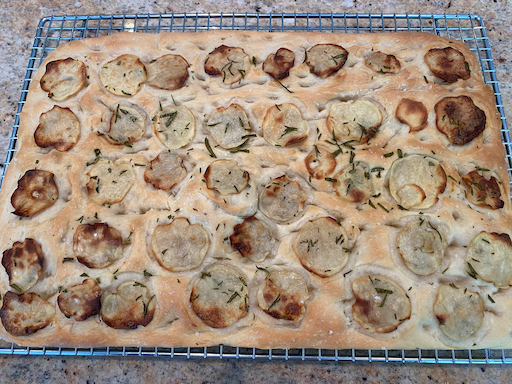This is the third iteration of Japanese "Satsuma-imo" sweet potato roll/muffin. In dealing with various food shortages during the covid-19 crisis we took an inventory of the foods we had in the freezer. My wife discovered a package of prepared satsuma-imo which she had prepared in the fall but forgotten about. She immediately decided to make sweet potato muffins. She basically used the recipe for the first version of sweet potato muffin and did not rise the dough over night in the refrigerator as she did in
version 2 . The good news is that we finally have regular yeast again (from Amazon, Fleischmann's instant yeast* 1 lb) so she did not use biga to make this. She used the usual amount of active yeast.
* Digression alert:
This is the largest amount of yeast we ever bought but this was the only package available. We usually buy a 4 oz jar of Fleischmann's active yeast. We are bit confused about the differences between "active", "instant" and "rapid-rise" or "rapid-acting" yeast. This is a somewhat confusing subject but
this web site appears to provide the most clear explanation. The following is what we understand from reading this article. The only difference between "active" and "instant" yeasts is the size of the granules. The granules in "active" yeast are larger than in "instant" yeast and require "proofing" or "activating" before being mixed into the rest of the ingredients. Because the granules in "instant" yeast are finer it can be mixed into dry ingredients without proofing. In addition, instant yeast unlike active yeast can be frozen--which we will have to do since this is such a large quantity. "Rapid-acting" and "Rapid-rising" yeasts are brand-specific names. These yeasts include additional ingredients that make rising faster and these yeasts are not suited for long fermentation such as overnight rising in the refrigerator or making over night pre-ferments.
This 3rd iteration of sweet potato muffin, is basically the same as the first version. The major difference is the mixture used for the stuffing. My wife didn't have enough sweet potato to just use that in the stuffing as she did in the original version so she used a mixture of ricotta cheese and sweet potato instead. As you can see, as it cooked steam made a space over the stuffing but the muffin tasted really good. We like this stuffing better.
She brushed the top with melted butter before placing into the oven.
Ingredients:
for the bread
1 cup of processed sweet potato (1/2 cup for the bread and about 1/2 cup to use as filling in the bread)
4 1/2 teaspoons (two 1/4-ounce packets) active dry yeast
1/4 cup sugar
1/2 cup warm water (110 to 115 degrees)
3 large eggs
3 tablespoons melted unsalted butter
1 teaspoon salt
3 to 3 1/2 cups flour, plus more for the work surface
Oil, for greasing the proofing bowl.
an additional 1 tsp butter to brush on the muffins before baking
for the stuffing
1/2 cup processed sweet potato
1/2 cup ricotta cheese
Directions:
Process the sweet potato by cooking several Japanese sweet potatoes either in the Weber grill or microwave. Let cool, peel and thoroughly mash in a food mill so it is smooth. (Since we made this batch of sweet potatoes in the Weber one weekend to have with barbecued chicken it had butter and soy sauce previously added).
Combine the yeast with 1 tablespoon of the sugar and the warm water in the bowl of a stand mixer; proof for 5 minutes. Add the eggs and beat on low speed, then add the remaining sugar, the butter and salt. Beat on low speed for about 2 minutes (no need to scrape down the bowl), then add the sweet potato and beat for about 1 minute. Add 1 cup of the flour at a time, beating to form a slightly stiff dough that has pulled away from the sides of the bowl; add flour as needed to form dough. Knead on speed 2 for 7 to 10 minutes.
Transfer the dough to a lightly floured work surface; knead for 2 to 3 minutes. When it is smooth and springy, shape it into a ball. Use oil to lightly grease the inside of a large bowl, then place the dough in it, turning it to coat evenly. Cover the bowl with plastic wrap; let the dough rest for about 1 hour or until it has doubled in size. The dough will be ready when you can push 2 fingers into it and the indentations remain.
Meanwhile mix the remaining processed sweet potato and ricotta cheese in another bowl and set aside. (shown in picture below).
Punch down the dough. Cut into pieces weighing about 2 oz. each (about 56 g). Flatten the dough and put a small scoop of the sweet potato ricotta mixture in the middle. Pinch the dough around the sweet potato ball and form into a muffin. Place in a greased baking dish. Cover with plastic wrap; let the muffins rise for 45 minutes to 1 hour or until doubled in size. Just before baking brush with 1 tbs of melted butter. Cook in a preheated oven of 375 degrees for 18 to 20 minutes until golden.
These sweet potato muffins are definitely one of our favorites. They are very nice when stuffed with just excess processed sweet potato but these stuffed with sweet potato and ricotta cheese are even better. The ricotta cheese picks up the flavor of the potato and seems to accentuate it. It has a mild sweetness. In addition the filling is very smooth and creamy. This goes very well with the tenderness of the bread's texture.




















































